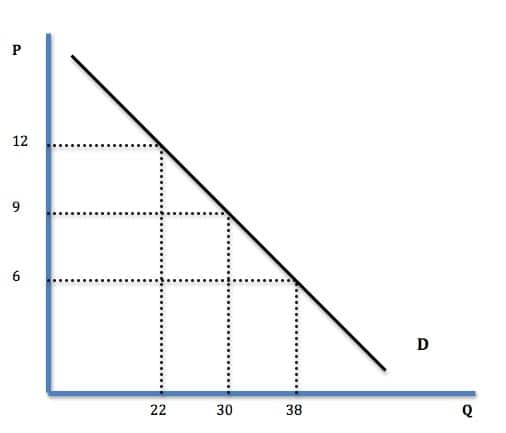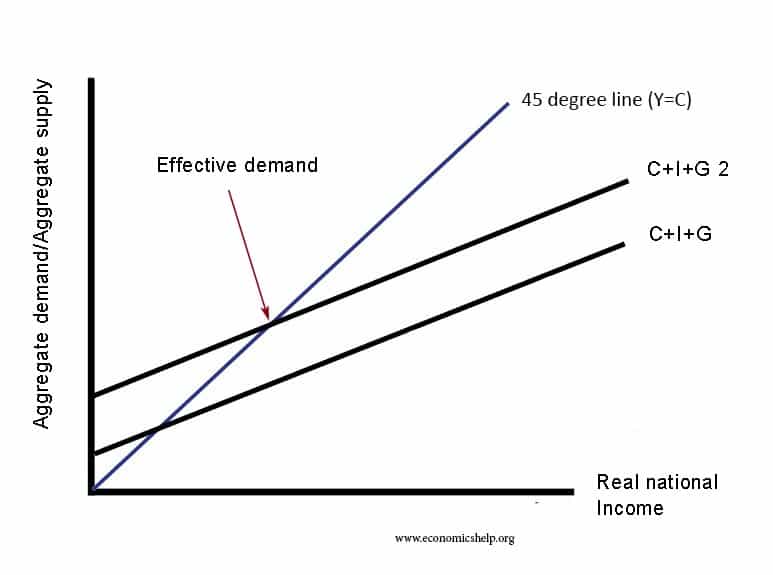Effective demand refers to the willingness and ability of consumers to purchase goods at different prices. It shows the amount of goods that consumers are actually buying – supported by their ability to pay.
Effective demand excludes latent demand – where the willingness to purchase goods may be limited by the inability to afford it – or lack of knowledge.
In Keynes’s macroeconomic theory, effective demand is the point of equilibrium where aggregate demand = aggregate supply. The importance of Keynes’ view is that effective demand may be insufficient to achieve full employment due to unemployment and workers without income to produce unsold goods.
Demand curve showing individual’s effective demand

In this case, the consumer will be willing and able to purchase 22 goods when the price is £12.
Factors affecting effective demand
The main factors affecting ‘effective demand’ will be
- Price
- Income – a rise in income will tend to cause rising demand.
- Availability of credit. If consumers and firms are able to borrow, then they have an effective demand to buy or invest. If credit is constrained, their effective demand is limited by the lack of access to credit.
See also: Factors affecting demand
Effective demand in Keynes’ General Theory
David Ricardo and John Baptiste Say held the view that “Supply creates its own demand” (this is the simplification of Keynes). In other words, if supply increases, the demand will be there.
However, in looking at the Great Depression, Keynes argued that effective demand could be less than necessary to achieve equilibrium. If demand falls, it can create a negative multiplier effect which causes unemployed resources. In Keynes theory, the level of ‘effective aggregate demand’ determines equilibrium national income.
The level of effective demand will be where the aggregate demand curve equals aggregate supply
Keynes argued there may be a case to boost effective demand
Latent demand
Demand is said to be latent if consumers would like to be able to purchase the good. For example, usually, a consumer would buy three loaves of bread per week. But, if he has an unexpected drop in income, he may not be able to afford the loaves. When his income returns to normal, his latent demand will return to effective demand.
Also, a new medicine could have a strong latent demand, but because people are not aware of its efficacy, they don’t buy. If there is a better knowledge of the good, then that latent demand will be realised.
Many firms can tap into latent demand for luxury goods by offering enticing credit deals – where the consumer can buy the goods on credit. 0% interest-free deals can be an effective way of turning latent demand into effective demand.
Example of effective demand
Students who have sufficient income or wealthy parents can effectively demand university education. Students with no parental backing may not have the effective demand to study at university.
Effective demand and derived demand
Derived demand occurs when there is demand for a good or service depending on demand for an intermediary. For example, demand for a peak railcard is dependent on demand for labour. With economic growth, there is a greater derived demand for transport for two reasons.
With higher pay, we now have more income and see a rise in our ability to pay (effective demand). Also, we need transport in order to get to work. If we are unemployed we cannot afford to travel around the country
Related


Very helpful
Thanks
Sorry I want to know differences between effective demand and derived demand in economy
sorry explain for me factor that limit effective demand in an economy.
Effective demand is the amount of any quantity actually sold in the markets while derived demand depends on the amount of another good or service and therein demanded due to that other factor e.g. labor is demanded when new capital machinery is acquired by a firm.
Explain why effective demand is equal to national income by Keynes theory
Is effective demand only possible at full employment level?
No, effective demand is when the aggregate demand is equal to aggregate supply. Here aggregate demand means the total demand of all the goods and services produced in an economy.and aggregate supply is total volume of goods and services produced in an economy . I hope u understand it very well.if u have any doubt than ask it .
Effective demand when increase then employment rate is increase. And effective demand for the decrease then employment rate is decrease. It is a postive relation between effective demand anb employment